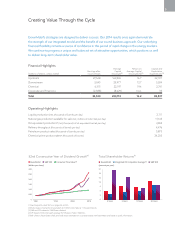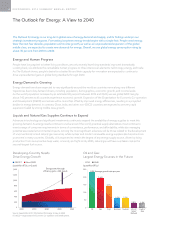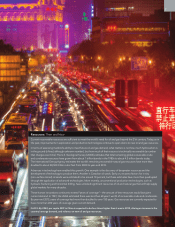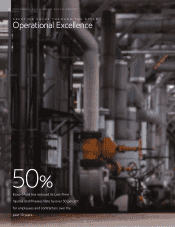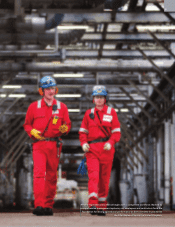Exxon 2014 Annual Report Download - page 17
Download and view the complete annual report
Please find page 17 of the 2014 Exxon annual report below. You can navigate through the pages in the report by either clicking on the pages listed below, or by using the keyword search tool below to find specific information within the annual report.
Production Ramp-Up
While the full field development
was being progressed,
ExxonMobil installed facilities
to bring early oil production to
local markets. First oil from the
Banyu Urip field was produced
in 2008. An early production
facility started up in 2009 with
an initial production capacity of
20 thousand barrels of oil per day.
As new wells were brought online,
production increased to more
than 40 thousand barrels per day.
Total oil production will continue
to ramp up until it reaches full field
capacity in 2015.
From Indonesia, for Indonesia
The Banyu Urip project has focused on developing the skills and knowledge base of Indonesian nationals through training
and use of local contractors and suppliers. During project execution, 460 national companies supported the EPC consortiums
as subcontractors, with 85 percent originating from areas neighboring the project facilities. At its peak, over 10,000
Indonesian workers were involved in the construction of facilities, with thousands coming from communities in the immediate
surroundings. Overall, ExxonMobil delivered 2 million training hours to Indonesian workers through 2,500 courses.
Increasing Indonesia’s industrial capability has been a key focus area for the project team. The mooring tower and support
structures, at a combined weight of over 3,800 tonnes, were fabricated on Java Island. Two 1,500-horsepower drilling
rigs, the first ever constructed entirely in Indonesia, are being used to drill project wells. The positive legacy of Banyu Urip’s
construction will live on through the workers who continue to benefit from our training and mentoring programs.
The project’s impact will continue into the operations of the facilities and last for decades. More than 100 operations
and maintenance technicians are being trained to operate the facilities during the production phase. Some have
completed on-the-job training at ExxonMobil operations in Angola, Cameroon, Malaysia, Nigeria, and the United States.
These Indonesian employees have returned home following the completion of their overseas assignments to run the
Banyu Urip operations.
Being a Great Neighbor
ExxonMobil has invested in various community programs in East Java. More than 70,000 community members have
benefited from our programs focused on education, health, and economic development. From teacher training (3,000
trained, serving 33,000 students) and educational assistance, to clean water and biogas supplies, to micro-loans for local
citizens to begin new businesses, the Banyu Urip project has contributed greatly to the local communities.
The project will also provide substantial economic benefits to the country. The total investment of more than $3 billion
is expected to generate $30 billion in revenue for the Government of Indonesia.
Overall, the Banyu Urip project is making a significant positive impact in Indonesia, both as the nation’s largest new oil
project, and as a key driver of economic growth and community enhancement.
Once fully commissioned, the Banyu Urip facilities are anticipated to produce up to
165 thousand barrels of oil per day at peak capacity.
15


